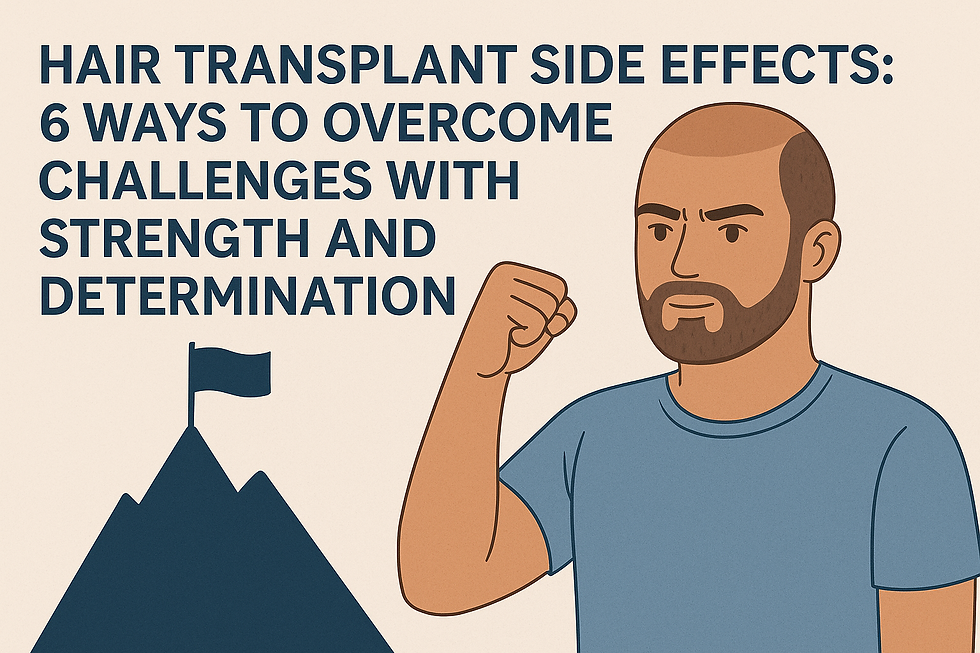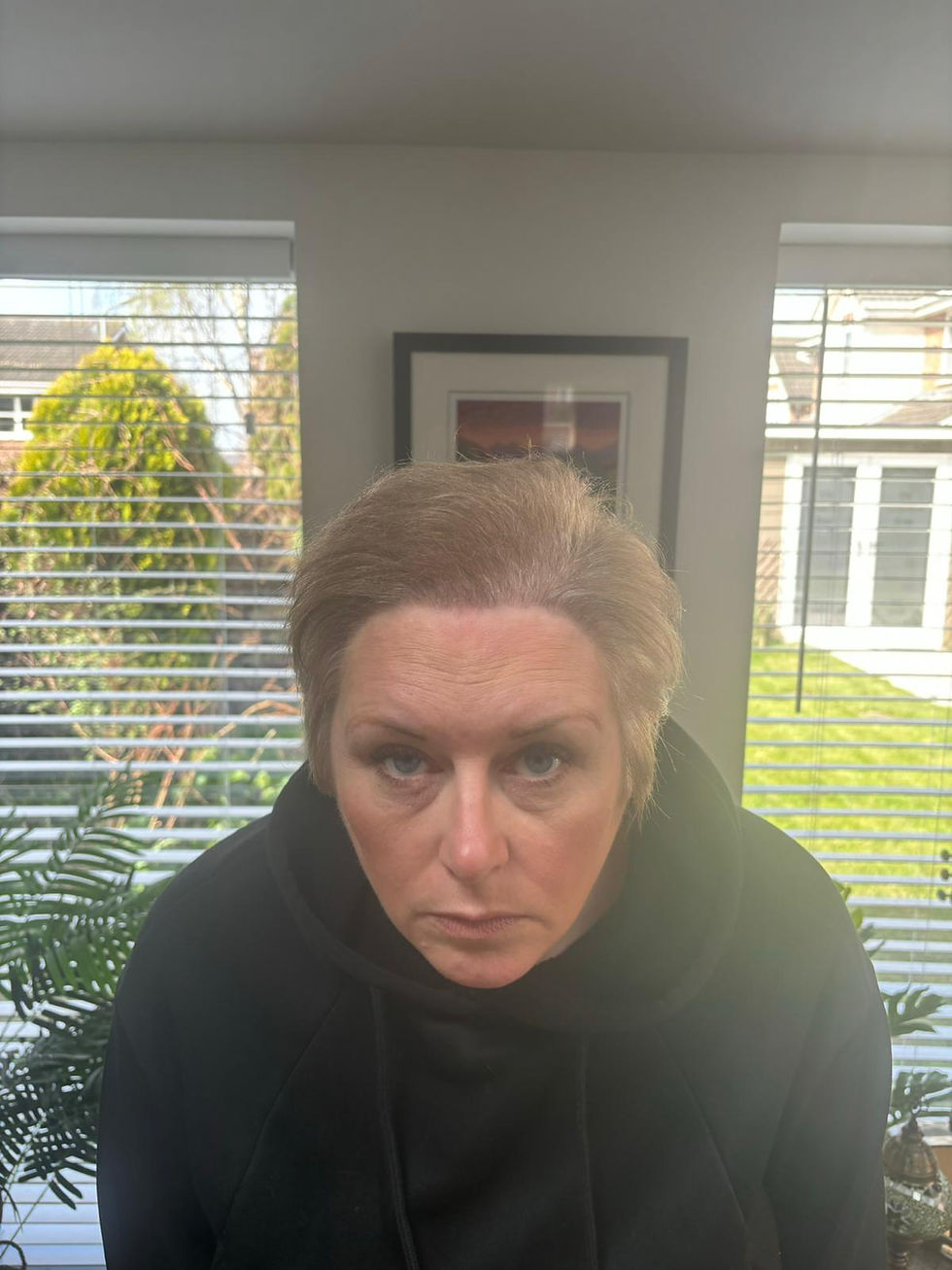Hair Transplant Side Effects: 6 Ways to Overcome Challenges with Strength and Determination
- Vita Hair Clinic

- Jan 13, 2024
- 4 min read
Updated: Jul 26

Introduction: Understanding the Journey to Thicker Hair
Welcome to the ultimate guide on hair transplant side effects, a topic that concerns anyone seeking to restore a full head of hair through transplantation.
Hair loss is a common concern for many individuals, and hair transplant procedures offer a promising solution.
However, like any medical intervention, hair transplantation comes with potential side effects that must be thoroughly understood before making a decision.
In this article, we’ll delve deep into the various aspects of hair transplant side effects, providing you with comprehensive insights and actionable advice.
From the initial consultation to the recovery phase, we’ll guide you through the entire process, offering expert tips and addressing your frequently asked questions.
What is a Hair Transplant and How Does It Work?
Before diving into the potential side effects, let’s briefly discuss what a hair transplant entails.
A hair transplant is a surgical procedure that involves moving hair follicles from one part of the body (usually the back or sides of the head) to an area with thinning or no hair, typically the scalp.
The transplanted hair grows naturally, providing a long-lasting solution to hair loss.
Hair Transplant Side Effects: The Lowdown
With the excitement of getting a hair transplant, it’s crucial to be aware of the potential side effects.
While most individuals experience successful procedures without any complications, it’s essential to consider the following potential side effects:
1. Hair Transplant Shock Loss:
One common side effect is shock loss, where transplanted hairs may temporarily fall out shortly after the procedure. This phenomenon is a natural part of the hair growth cycle and not a cause for concern.
2. Infection and Bleeding:
As with any surgery, there is a risk of infection and bleeding at the transplant site. However, following the post-operative care guidelines strictly can significantly reduce these risks.
3. Scarring:
Scarring is an inherent part of any surgical procedure. However, modern techniques, such as DHI (Direct Hair Implantation), minimize visible scarring, making it less noticeable.
4. Itching and Discomfort
During the healing process, some individuals may experience itching and discomfort at the transplant site. It’s essential to avoid scratching to prevent any damage to the newly transplanted hair follicles.
5. Swelling:
Temporary swelling can occur in the forehead or around the eyes following a hair transplant. This should subside within a few days.
6. Numbness:
Temporary numbness may occur in the donor and recipient areas. This is usually a short-term effect and resolves over time.
7. Cysts:
In some cases, small cysts may form around hair follicles following the transplant. These cysts are usually harmless and disappear on their own.
8. Hiccups:
Believe it or not, some patients may experience hiccups after a hair transplant procedure. This is a rare side effect and usually subsides quickly.
9. Unnatural Appearance:
Inexperienced surgeons or improper transplantation techniques can lead to an unnatural appearance. Choosing a skilled and reputable hair transplant surgeon is crucial to avoid this side effect.
10. Keloid Formation:
Individuals with a predisposition to keloid scarring may experience keloid formation at the donor or recipient site.
11. Shock Alopecia:
In rare cases, some individuals may experience shock alopecia, which is the temporary shedding of natural hair surrounding the transplanted area. This typically resolves within a few months.
How to Minimize Hair Transplant Side Effects?
While the possibility of side effects exists, you can take proactive steps to minimize their impact. Here are some essential tips to reduce the risk of hair transplant side effects:
1. Choose a Skilled Surgeon:
Selecting a qualified and experienced hair transplant surgeon is crucial to ensure a successful procedure and minimize the risk of complications.
2. Follow Post-Operative Instructions:
Strictly adhere to the post-operative care instructions provided by your surgeon. This includes avoiding excessive sun exposure, refraining from strenuous activities, and taking prescribed medications.
3. Maintain a Healthy Lifestyle:
A healthy lifestyle promotes better healing and overall well-being. Eat a balanced diet, stay hydrated, and avoid smoking and excessive alcohol consumption.
4. Avoid Scratching or Picking:
Resist the temptation to scratch or pick at the transplant site, as this can damage the newly transplanted follicles and lead to infection.
5. Attend Follow-Up Appointments:
Regularly attend follow-up appointments with your surgeon to monitor the healing process and address any concerns promptly.
6. Be Realistic with Expectations:
Understand that hair transplantation is not a quick fix, and results take time to fully manifest. Be patient and maintain realistic expectations.
When to Seek Medical Attention
While most side effects of hair transplant surgery are temporary and resolve on their own, there are some situations where patients should seek medical attention. These include:
Signs of infection: Patients should look out for signs of infection, such as fever, redness, and swelling.
Excessive bleeding: If bleeding does not stop on its own, patients should seek medical attention.
Severe pain or discomfort: While some discomfort is normal after surgery, severe pain or discomfort may be a sign of a complication.
Abnormal swelling or redness: Patients should contact their surgeon if they experience abnormal swelling or redness in the transplanted area.
Conclusion
Hair transplant surgery is a safe and effective way to combat hair loss, but it does come with potential risks and complications.
By choosing a qualified and experienced hair transplant surgeon, following pre and postoperative instructions, and taking care of your scalp after the procedure, you can minimize your risk of side effects and ensure a successful outcome.ˆ1
If you experience any signs of a complication, it is important to seek medical attention right away.
FAQ about hair transplant side effects
How long do hair transplant side effects last?
The duration of side effects varies from person to person. Most side effects, such as swelling, numbness, and itching, subside within a few days to weeks.
Can I resume my normal routine after a hair transplant?
It’s essential to avoid strenuous activities and direct sun exposure for the first few weeks after a hair transplant. Follow your surgeon’s instructions for a smooth recovery.
Is hair transplant shock loss permanent?
No, hair transplant shock loss is temporary. The transplanted hairs typically fall out initially but will regrow naturally within a few months.
Are hair transplant side effects more common in men or women?
Hair transplant side effects can occur in both men and women, but the frequency and severity may vary based on individual factors.













.png)
Comments